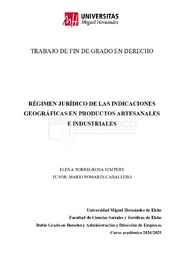Por favor, use este identificador para citar o enlazar este ítem:
https://hdl.handle.net/11000/37392Registro completo de metadatos
| Campo DC | Valor | Lengua/Idioma |
|---|---|---|
| dc.contributor.advisor | Pomares Caballero, Mario | - |
| dc.contributor.author | Torregrosa Sempere, Elena | - |
| dc.contributor.other | Departamentos de la UMH::Ciencia Jurídica | es_ES |
| dc.date.accessioned | 2025-09-15T08:58:43Z | - |
| dc.date.available | 2025-09-15T08:58:43Z | - |
| dc.date.created | 2025-06 | - |
| dc.identifier.uri | https://hdl.handle.net/11000/37392 | - |
| dc.description.abstract | En la actualidad, existen multitud de productos autóctonos dotados de un reconocimiento social superior por el signo distintivo de Indicación Geográfica que los amparan, ya que mediante tal sello de calidad se vincula el producto con la región de origen, de forma que se le atribuyen unos elementos naturales y/o humanos propios del lugar donde han sido producidos. Tradicionalmente, la Unión Europea ha venido certificando los productos agroalimentarios, vinos y bebidas espirituosas que se han ceñido a los estándares de calidad y características exigidas en su regulación, pero con la aprobación del Reglamento (UE) 2023/2411, el abanico de productos registrables se ha abierto significativamente, ya que ahora el Parlamento Europeo y el Consejo contemplan la posibilidad de obtención de distintividad a los productos artesanales e industriales que decidan acogerse a su régimen jurídico, en aras de fomentar el saber hacer artesanal y tradicional, así como de preservar la cultura de nuestra sociedad. | es_ES |
| dc.description.abstract | Currently, there is a multitude of local products with a higher social recognition due to the distinctive Geographical Indication sign that protects them, as the quality seal links the product to the region of origin, so that it is attributed with natural and/or human elements that are specific to the place where they have been produced. Traditionally, the European Union has been certifying agri-food products, wines and spirits that have complied with the quality standards and characteristics required by its regulations. Nevertheless, the range of registrable products has opened up significantly with the creation of Regulation (EU) 2023/2411, as the European Parliament and the Council now contemplate the possibility of obtaining distinctiveness for crafts and industrial products that decide to use its legal regime, in the interest of promoting artisanal and traditional expertise, as well as preserving the culture of our society. | es_ES |
| dc.format | application/pdf | es_ES |
| dc.format.extent | 49 | es_ES |
| dc.language.iso | spa | es_ES |
| dc.publisher | Universidad Miguel Hernández de Elche | es_ES |
| dc.rights | info:eu-repo/semantics/openAccess | es_ES |
| dc.rights | Attribution-NonCommercial-NoDerivatives 4.0 Internacional | * |
| dc.rights.uri | http://creativecommons.org/licenses/by-nc-nd/4.0/ | * |
| dc.subject | Indicación Geográfica | es_ES |
| dc.subject | Reglamento (UE) 2023/2411 | es_ES |
| dc.subject | armonización | es_ES |
| dc.subject | productos artesanales e industriales | es_ES |
| dc.subject | protección | es_ES |
| dc.subject | Geographical Indication | es_ES |
| dc.subject | Regulation (EU) 2023/2411 | es_ES |
| dc.subject | harmonization | es_ES |
| dc.subject | crafts and industrial products | es_ES |
| dc.subject | protection | es_ES |
| dc.subject.other | CDU::3 - Ciencias sociales | es_ES |
| dc.title | Régimen jurídico de las indicaciones geográficas en productos artesanales e industriales | es_ES |
| dc.type | info:eu-repo/semantics/bachelorThesis | es_ES |

Ver/Abrir:
TFG DERECHO. Torregrosa Sempere, Elena.pdf
1,15 MB
Adobe PDF
Compartir:
 La licencia se describe como: Atribución-NonComercial-NoDerivada 4.0 Internacional.
La licencia se describe como: Atribución-NonComercial-NoDerivada 4.0 Internacional.
.png)